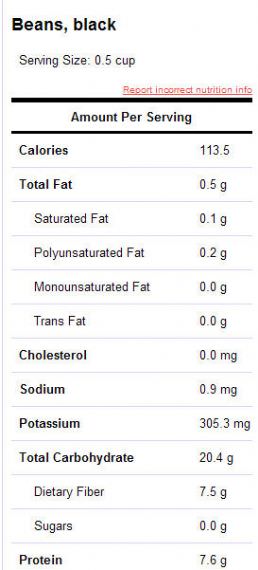|
Each Friday during Lent, the dailySpark is featuring a different meat-free main dish. Whether you observe Lent or not, we can all benefit from learning about alternate, affordable proteins. My boyfriend could live on black beans and rice. He actually said that Wednesday night. He got home late, and I had gone out to dinner with a friend. He opened a can of beans, doctored it with olive oil, garlic, curry and a strange assortment of spices and heated up some leftover brown rice. He added some smoked gouda and a handful of fresh spinach at the end (If I'm not eating it, I don't comment on the conglomerations he creates.) and his dinner was ready. "I could eat this every meal of every day and still be happy," Fred said. While I don't love black beans quite as much as my boyfriend does, I am very fond of these beans. They're cheap (I get a conventional 15-ounce can for 89 cents, an organic 15-ounce can for $1.29, and a pound of organic dried beans for about $1/pound.) I cook a big batch of dried black beans each week and we eat them throughout the week. We add a half-cup per serving to vegetable stir-fries, soups, stews and pretty much any other dish. What are they? Black beans, also called turtle beans, have thin, shiny black skin and creamy white insides. When mashed they look gray or dark purple. They have a smooth texture and retain their shape while cooking. Beans--including black beans--are virtually fat free, and they're a great source of protein. They taste smooth and slightly sweet, with a faint mushroom taste. According to WHFoods.com and the George Mateljan Foundation, "black beans are as rich in antioxidant compounds called anthocyanins as grapes and cranberries, fruits long considered antioxidant superstars."  How do I cook them? Cook black beans as you would any other bean. Canned beans are ready to throw in burritos, soups and salads after a quick rinse; dried beans need a bit more time, depending on whether you presoak them. (Tip: I cook dried beans in my rice cooker, and I know other people who make them in pressure cookers or slow cookers. ) (Find out how to cook dried beans--and how to make your beans less musical!) How do I eat them? Black beans are a staple in Caribbean, Central and South American cuisines, and they pair well with flavors common to those regions: chilies, cilantro, coriander, cumin, onion, peppers, and tomatoes. Black beans pair perfectly with cumin, which adds a slow-cooked, homemade flavor to any food. I never cook a pot of black beans without a couple of tablespoons of cumin. We frequently make some sort of Mexican DIY dish for dinner--think of it like a burrito without the tortilla. We start with 1/2 c brown rice (108 calories), add 1/2 c black beans (114), 1 cup fresh spinach (7), 1/2 c salsa (36 calories), and either 1/4 avocado (72 calories; 6.7 g fat), 2 T lowfat sour cream (40 calories; 4 g fat), or an ounce of grated low-fat cheddar cheese (50 calories, 2 g fat). We add chopped onions, cilantro and peppers, too. It's a filling and delicious meal (Fred usually has seconds) that is under 400 calories. Sometimes I put a poached egg on top--the creamy beans and the rich, runny yolk are a great combo! (I usually drizzle my dish with sriracha or another hot sauce. I LOVE spicy food!) Black beans are a great bean for people who think they don't like beans. Their flavor is mild and their texture smooth. Try throwing beans into your burritos, tacos or enchiladas, or make a batch of black bean soup. Recipes Black Bean Hummus This is a great all-purpose dip. Serve it with carrots and celery, spread it on a tortilla, or dip some baked chips into it. Black Bean Brownies Yes, even brownies can be made with black beans. The beans, when pureed, are virtually undetectable. They add fiber and replace fat. More Black Beans Recipes From Caribbean to Brazilian, refried or with rice, black beans are a great, cheap protein source! How do you cook black beans? |
More From SparkPeople
|















